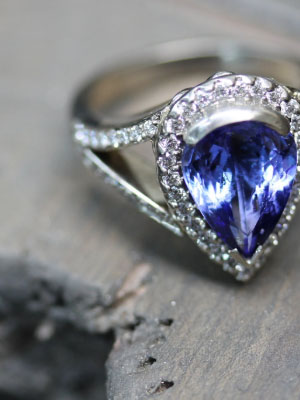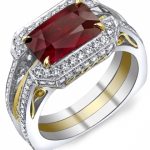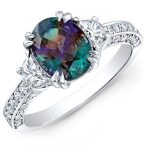
Tanzanite Tones and Saturation Tanzanite owes much of its beauty to an unusual gemological property called pleochroism, the ability to exhibit more than one color. When viewed from different directions, tanzanite can look blue, violet, purple, bronze or even gray. This is because Tanzanite is a trichroic gem. Very few stones are trichroic and this is what makes tanzanite’s very easy to identify. Trichroic refers to three layers of color. The more common layers are blues and purples but you may also see flashes of red, green, yellow, or even orange. The color that gemologists primarily speak of is the deep royal blue. Before a tanzanite is faceted, the gemstone cutter studies the crystal and decides which directional orientation will show the best color. And typically, most cutters will try to produce a pure blue tanzanite. Unfortunately, cutting to achieve a blue color sacrifices a lot of weight and results in a smaller and more costly gem. Yet the blue of a well cut tanzanite is so breathtaking that most agree the sacrifice is well worth it. Stones ranging over 4 carats and larger have been known to show the strongest blue color. Smaller tanzanite’s are usually soft blue, light violet or lilac purple.
THE COLORS OF TANZANITE
The term pleochroism which is the ability to exhibit more than color is where tanzanite owes much of its beauty. When viewed from different directions, tanzanite can look blue, violet, purple, bronze or even gray. This is because tanzanite is a trichroic gem. Trichroic refers to three layers of color. The more common layers are blues and purples. Deep royal blue is the color that gemologists speak of. Most cutters will try to produce a pure blue tanzanite. The blue of a well cut tanzanite is so breathtaking that most agree it’s well worth it. Smaller tanzanite’s are usually soft blue, light violet, or lilac purple.
RARITY OF TANZANITE
The east African state of Tanzania is the only place in the world where tanzanite’s can be found. In Merelani today, searches are limited because they are only in a few small mines. Unfortunately, in the absence of sophisticated mining techniques and inadequate financing, production never attains the level where supply complements demand.
TANZANITE RECONGNITION
Tanzanite has rapidly become one of the most conveted gemstones in the world. In October of 2002, the American Gem Trade Association (AGTA) announced that tanzanite had joined zircon and turquoise in the traditional list of birthstones for the month of December. The contemporary jewelers Anniversary Gemstone List also named Tanzanite the anniversary gemstone for the 24th year of marriage. Overall, the stone has had a true impact on the industry. We are proud to say that among the many gemstones discovered in the last 90 years, only Tanzanite has been officially added.
HEAT TREATMENT OF TANZANITE
Virtually all tanzanite is gently heated to bring out its rich blue, violet and purple hues. The heat treatments are conducted at approximately 700 degree Celsius temperature, in order to enhance and bring out the best color possible. Overall, enhancement using heat treatment is a widely accepted treatment for the Tanzanite gem stone.
TIPS FOR TANZANITE
Tanzanite should never be cleaned with an ultrasonic or steam machine, or brought into contact with any type of acids. Tanzanite can be cleaned with mostly any commercial jewelry cleaner or plain soap and warm water using a soft brush. Be sure to rinse and dry thoroughly after cleaning. Also avoid exposing your stone to sudden changes of temperature. This includes hot tubs and very cold water. Do not wear when doing any type of physical labor. Tanzanite should always be worn carefully. This gemstone is a bit more delicate than many other gemstones and therefore cannot be worn when doing laborious activity. If you should be getting a Tanzanite ring resized or repaired, ensure that the gemstone is first taken off from the mounting. The Tanzanite gemstone could shatter with the heat of a torch.



